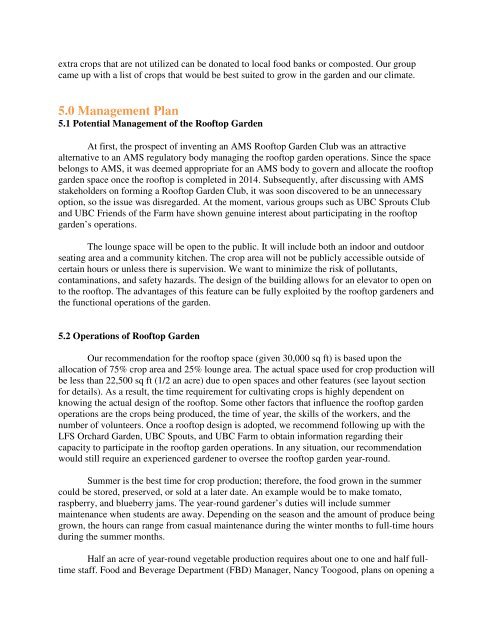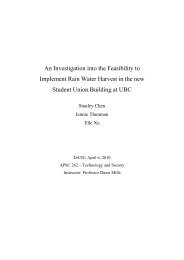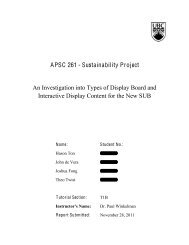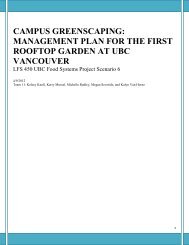LFS 450 - My New Sub
LFS 450 - My New Sub
LFS 450 - My New Sub
You also want an ePaper? Increase the reach of your titles
YUMPU automatically turns print PDFs into web optimized ePapers that Google loves.
extra crops that are not utilized can be donated to local food banks or composted. Our group<br />
came up with a list of crops that would be best suited to grow in the garden and our climate.<br />
5.0 Management Plan<br />
5.1 Potential Management of the Rooftop Garden<br />
At first, the prospect of inventing an AMS Rooftop Garden Club was an attractive<br />
alternative to an AMS regulatory body managing the rooftop garden operations. Since the space<br />
belongs to AMS, it was deemed appropriate for an AMS body to govern and allocate the rooftop<br />
garden space once the rooftop is completed in 2014. <strong>Sub</strong>sequently, after discussing with AMS<br />
stakeholders on forming a Rooftop Garden Club, it was soon discovered to be an unnecessary<br />
option, so the issue was disregarded. At the moment, various groups such as UBC Sprouts Club<br />
and UBC Friends of the Farm have shown genuine interest about participating in the rooftop<br />
garden’s operations.<br />
The lounge space will be open to the public. It will include both an indoor and outdoor<br />
seating area and a community kitchen. The crop area will not be publicly accessible outside of<br />
certain hours or unless there is supervision. We want to minimize the risk of pollutants,<br />
contaminations, and safety hazards. The design of the building allows for an elevator to open on<br />
to the rooftop. The advantages of this feature can be fully exploited by the rooftop gardeners and<br />
the functional operations of the garden.<br />
5.2 Operations of Rooftop Garden<br />
Our recommendation for the rooftop space (given 30,000 sq ft) is based upon the<br />
allocation of 75% crop area and 25% lounge area. The actual space used for crop production will<br />
be less than 22,500 sq ft (1/2 an acre) due to open spaces and other features (see layout section<br />
for details). As a result, the time requirement for cultivating crops is highly dependent on<br />
knowing the actual design of the rooftop. Some other factors that influence the rooftop garden<br />
operations are the crops being produced, the time of year, the skills of the workers, and the<br />
number of volunteers. Once a rooftop design is adopted, we recommend following up with the<br />
<strong>LFS</strong> Orchard Garden, UBC Spouts, and UBC Farm to obtain information regarding their<br />
capacity to participate in the rooftop garden operations. In any situation, our recommendation<br />
would still require an experienced gardener to oversee the rooftop garden year-round.<br />
Summer is the best time for crop production; therefore, the food grown in the summer<br />
could be stored, preserved, or sold at a later date. An example would be to make tomato,<br />
raspberry, and blueberry jams. The year-round gardener’s duties will include summer<br />
maintenance when students are away. Depending on the season and the amount of produce being<br />
grown, the hours can range from casual maintenance during the winter months to full-time hours<br />
during the summer months.<br />
Half an acre of year-round vegetable production requires about one to one and half fulltime<br />
staff. Food and Beverage Department (FBD) Manager, Nancy Toogood, plans on opening a











